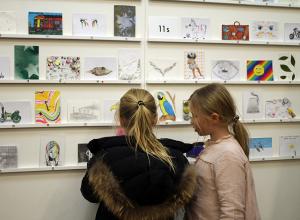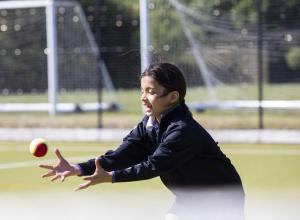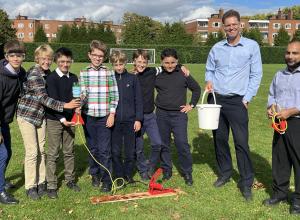
Anchor tasks are key to ensuring that pupils of all abilities are engaged and inspired by Maths lessons. Warren Rodricks, explains why they work so well
Far and away the most common question parents ask me about mixed ability Maths teaching is this one: How do you ensure that every student, whatever his or her ability, is kept engaged and motivated whilst still making progress? If you share similar concerns about your child, let me reassure you. If teachers come to their lessons well planned and well prepared – invariably the case at Harrodian – the issue doesn’t arise. Enrichment is a required ingredient that is built into the fabric of every lesson in our classrooms, but not in the form of ‘extensions’ that take our pupils away from the year group curriculum. Instead, we encourage activities intended to take pupils' understanding deeper into the concept, however fast they’re picking it up, ensuring the gap between the attainment of different pupils is not widened. How do we do this? One of the key tools is our Anchor Task.
Enrichment that takes pupils' understanding deeper into the concept is a required ingredient that is built into the fabric of every lesson
The Anchor Task opens the lesson. It is set up to give pupils a chance to explore the activity independently, as part of a partnership or in small groups. It requires dialogue between pupils and can tap into prior learning or the world beyond the classroom whilst stimulating and challenging children’s thinking. Good Anchor Tasks do this at various levels so all pupils of all abilities benefit. We call them ‘low-entry, high-ceiling’ activities. In essence, ‘low-entry’ means we want them to be easily accessible for all pupils to engage with. While ‘high ceiling’ means the task also offers numerous built-in opportunities to support further learning, as pupils become familiar with the idea. An example is set out below:
Objective: Add 3-digit numbers
⬜⬜⬜ __________________________ = ⬜⬜⬜ |
Let’s take apart the activity to examine how and why it works. Top of our list of requirements for effective mixed ability teaching is collaboration. Dialogue – between teachers and pupils and, crucially, between pupils – plays a key role throughout the lesson. Tasks are built so that they prompt discussion that supports all pupils as they take part. Both for the explainers and for those receiving explanation, discussing maths one to one provides opportunities to develop understanding in every lesson. Setting out an idea so that someone else understands is challenging. Doing it helps higher attaining mathematicians gain a deeper insight into a concept. By the same token, those struggling with concepts in their own maths gain confidence from regular exposure to the language and processes of stronger mathematicians. Put simply, it’s a Win-Win.
Top of our list of requirements is collaboration. Dialogue – between teachers and pupils and, crucially, between pupils – plays a key role throughout every lesson.
Next on our list of mixed ability essentials is ‘concrete’ apparatus. These physical props can often be a lot simpler than they sound. In this case, our tool consists of a collection of post-its. Simple as they are the Post its can make a big difference, providing a way to practise the skill of addition that pupils find more engaging and 'safer'. For one thing, if pupils make a mistake, it is not committed to paper and they can simply re-organise the post-its for a quick change to the sum. For another, the ‘playful’ atmosphere these simple props create encourages the sort of active participation from children that allows all pupils to take control of their learning. This makes the activity open to all and even allows pupils low in confidence to feel they can take risks safely. The added benefit of so-called ‘manipulatives’ is that they open up mathematical concepts, helping a learner to create meaning in a way they can physically feel at their fingertips.
Physical props can make a big difference, providing ways to learn skills and to create meaning in a way that pupils can feel at their fingertips
The beauty of a good anchor task like this one is that it’s easy to build in activities that ‘stretch’ higher attaining learners. The original task as stated above, is to add two 3-digit numbers together to form another 3-digit number, without repeating any of the numbers used. The goal is to create as many number sentences as possible. As pupils succeed, we can add more complex challenges. One next step would be to ask learners to create the largest sum or the smallest sum possible with the post-it numbers and to explain how they know it is the largest or smallest sum. We can blend in knowledge of multiples by asking for an answer that is a multiple of 5 or 6.
The beauty of a good anchor task is that it’s easy to build in activities that ‘stretch’ higher attaining learners
My favourite conclusion to this challenge is to ask the pupils to use two 3-digit numbers to make a 4-digit number starting with the number 2, whilst allowing them to repeat any number they wish, more than once even. The challenge then looks like this:
Objective: Add 3-digit numbers
⬜⬜⬜+ ⬜⬜⬜ ____________________________ = 2 ⬜⬜⬜ |
A pupil’s eyes will often light up when they hear that they can repeat any number they want to. The result is that there are usually a whole lot of 9s created. Which is great. The partners then work together to try and find an answer, spending time in discussion, experimentation and refinement, all of it creating deeper levels of understanding. And once in a while, a pupil will also show great number insight by stopping early in the task and telling me, ‘It can’t be done, Sir’ before launching into an explanation why not. (I’m leaving the reasons why for you to figure out here!)
Every one of our pupils deserves both to be challenged and to be supported. The beauty of mastery and cleverly planned Anchor Tasks means this happens every lesson for each of them
We believe every one of our pupils deserves both to be challenged and to be supported. The beauty of mastery and cleverly planned Anchor Tasks means this happens every lesson for each of them. We don’t ‘water-down’ the curriculum, or lower expectations. Instead, we provide the opportunity for all of our pupils to discuss the maths that’s on their minds and in the world around them...And more will follow on this last subject in my next blog.

Mr Rodricks welcomes feedback on this blog to website@harrodian.com







